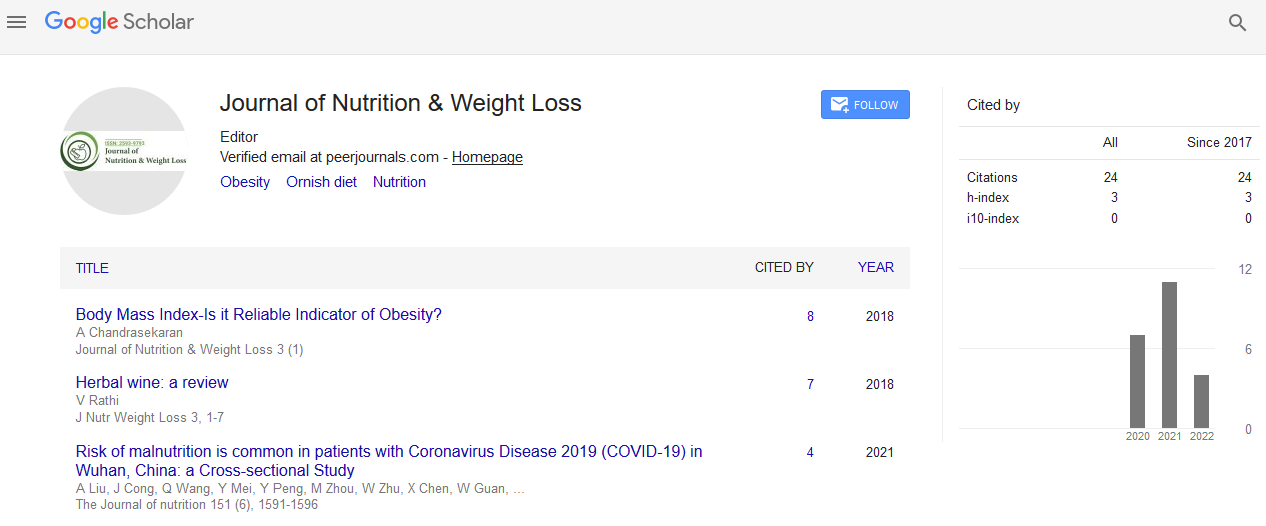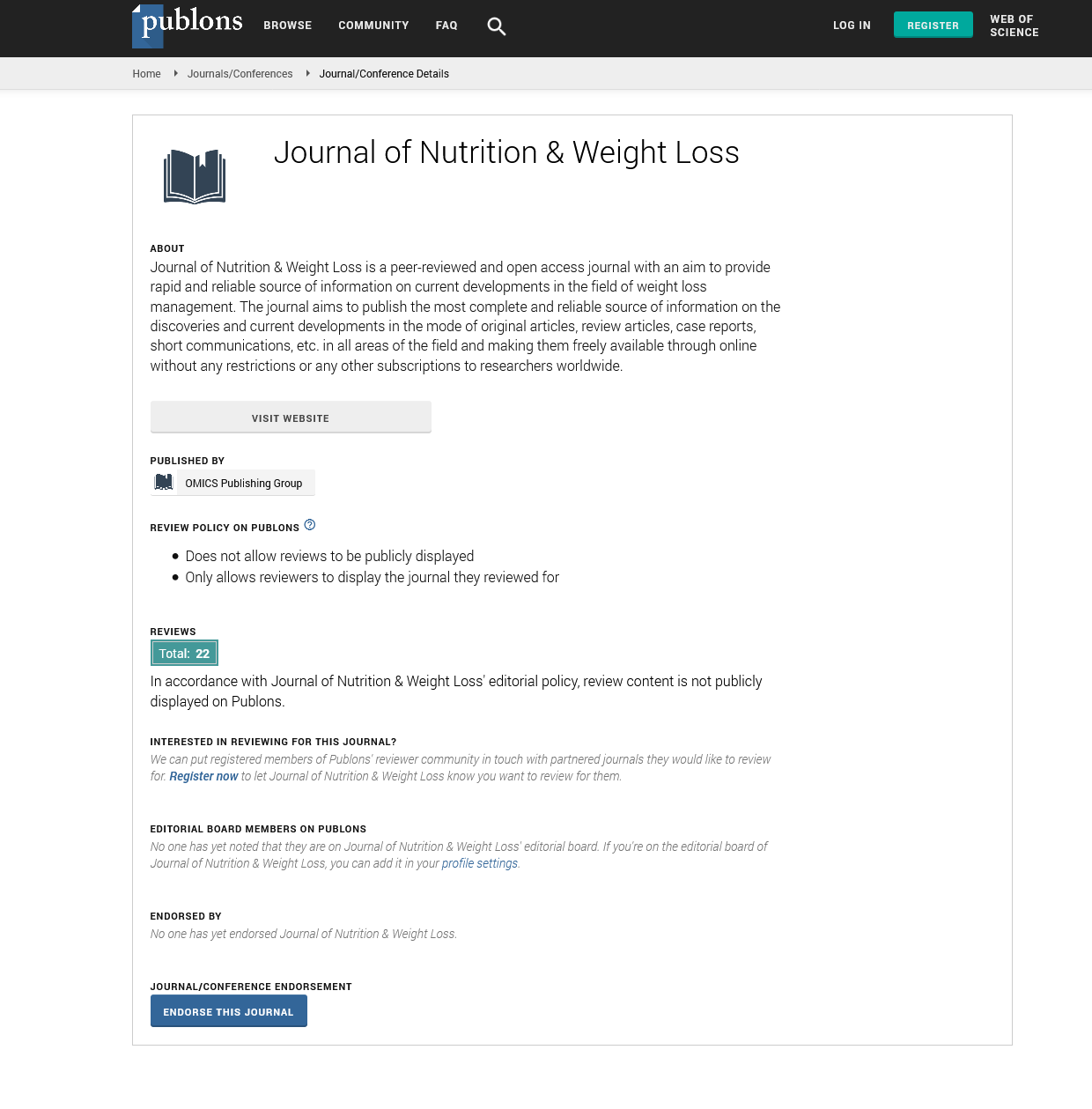Indexed In
- RefSeek
- Hamdard University
- EBSCO A-Z
- Publons
- Euro Pub
- Google Scholar
Useful Links
Share This Page
Journal Flyer

Open Access Journals
- Agri and Aquaculture
- Biochemistry
- Bioinformatics & Systems Biology
- Business & Management
- Chemistry
- Clinical Sciences
- Engineering
- Food & Nutrition
- General Science
- Genetics & Molecular Biology
- Immunology & Microbiology
- Medical Sciences
- Neuroscience & Psychology
- Nursing & Health Care
- Pharmaceutical Sciences
Opinion Article - (2023) Volume 8, Issue 4
The Potentiality of Macronutrients: A Comprehensive Guide to Balanced Nutrition
Izabella Barbosa*Received: 27-Nov-2023, Manuscript No. JNWL-23-24755; Editor assigned: 30-Nov-2023, Pre QC No. JNWL-23-24755 (PQ); Reviewed: 14-Dec-2023, QC No. JNWL-23-24755; Revised: 21-Dec-2023, Manuscript No. JNWL-23-24755 (R); Published: 28-Dec-2023, DOI: 10.35248/2593-9793.23.8.188
Description
Macronutrients, consisting of carbohydrates, proteins, and fats, are the essential components of our diet, providing the energy and building blocks necessary for optimal functioning of the human body. Understanding the roles and sources of these macronutrients is crucial for maintaining a wellbalanced and nutritious diet. In this article, we explore the significance of each macronutrient, their functions, and how to strike a harmonious balance to support overall health.
Carbohydrates
Carbohydrates are the body's primary source of energy, fuelling various physiological processes. They are classified into simple carbohydrates (sugars) and complex carbohydrates (starches and fibres). Whole grains, fruits, vegetables, and legumes are excellent sources of complex carbohydrates, providing sustained energy release. However, it's essential to choose whole, unprocessed sources to maximize nutritional benefits and fibre content.
Glucose, derived from carbohydrates, is the preferred energy source for the brain, emphasizing the importance of maintaining an adequate carbohydrate intake for cognitive function.
Proteins
Proteins are the building blocks of life, composed of amino acids that contribute to the growth, repair, and maintenance of tissues and organs. Good sources of complete proteins, containing all essential amino acids, include meat, fish, eggs, and dairy products.
Plant-based sources such as legumes, nuts, and grains can also provide a variety of amino acids when combined appropriately. Adequate protein intake is important for muscle development, immune function, enzyme production, and hormone synthesis.
Fats
Fats often carry a negative connotation, but they are vital for various physiological functions. Healthy fats, such as monounsaturated and polyunsaturated fats, support cell structure, aid in nutrient absorption (especially fat-soluble vitamins), and contribute to hormone production.
Sources of healthy fats include avocados, olive oil, nuts, seeds, and fatty fish. Saturated fats and Trans fats, found in processed and fried foods, should be limited, as excessive consumption can contribute to cardiovascular issues. Striking a balance between different types of fats is key to a heart-healthy diet.
Balancing macronutrients for optimal nutrition
Achieving a balanced diet involves consuming the right proportions of carbohydrates, proteins, and fats to meet individual nutritional needs. Consider the following guidelines:
Caloric distribution: While individual requirements vary, a common recommendation is to allocate about 45%-65% of daily calories from carbohydrates, 10%-35% from proteins, and 20%-35% from fats. Adjustments may be necessary based on factors such as age, activity level, and health goals.
Quality matters: Choose nutrient-dense sources within each macronutrient category. Opt for whole grains, lean proteins, and healthy fats to ensure a well-rounded intake of essential vitamins and minerals.
Individualized needs: Factors such as age, gender, activity level, and health conditions influence macronutrient requirements.
Conclusion
Macronutrients are the foundation of a healthy and balanced diet, providing the energy and essential components necessary for overall well-being. Striking the right balance between carbohydrates, proteins, and fats, while focusing on nutrientdense sources, is key to supporting bodily functions and achieving long-term health goals. By understanding the roles of each macronutrient and making informed dietary choices, individuals can start on a journey towards optimal nutrition and a healthier lifestyle.
Citation: Barbosa I (2023) The Potentiality of Macronutrients: A Comprehensive Guide to Balanced Nutrition. J Nutr Weight Loss. 8:188.
Copyright: © 2023 Barbosa I. This is an open access article distributed under the terms of the Creative Commons Attribution License, which permits unrestricted use, distribution, and reproduction in any medium, provided the original author and source are credited.


